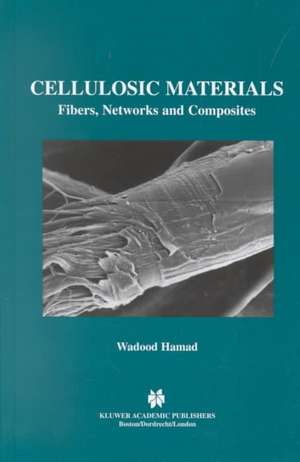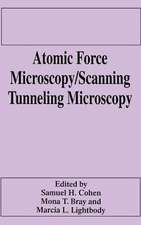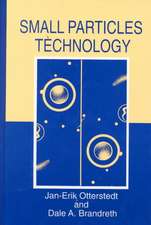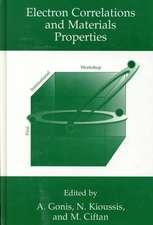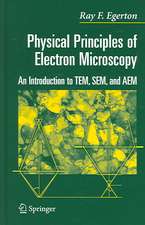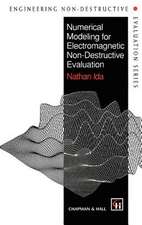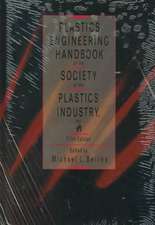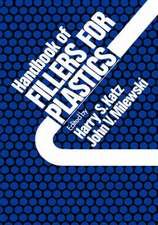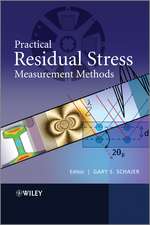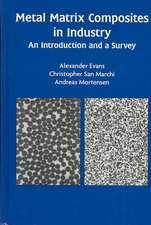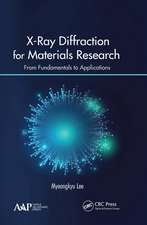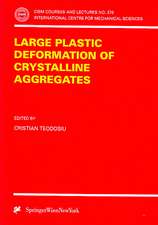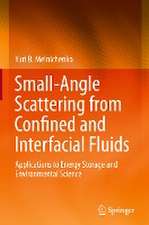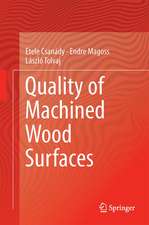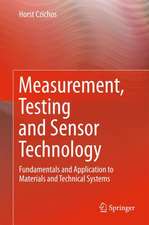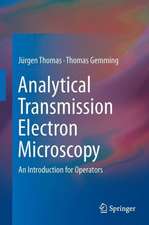Cellulosic Materials: Fibers, Networks and Composites
Autor Wadood Y. Hamaden Limba Engleză Hardback – 30 dec 2001
The book is structured in five chapters which provide a sequential treatment of the running theme: deformation mechanics and the physical, morphological and mechanical characterization of native cellulose fibers networks and composites.
The heart of the book is Chapter 3, Damage Accumulation in Fibers, which treats the experimental methodology for fatigue testing of single fibers and the engendered results. In-depth examinations of the morphology, structure and chemical composition of native cellulose fibers, and the mechanics of deformation in these natural composite fibers are proffered in Chapters 1 and 2, respectively.
The fourth chapter, Fractal Simulation of Crack Propagation, presents a fractal-based approach to modeling damage accumulation in materials. Fractals lend themselves well to modeling such randomly-oriented phenomena as crack propagation and fracture.
The last chapter, Fibrous Structures: Networks and Composites, comprises analytical approaches for handling networks and composites.
| Toate formatele și edițiile | Preț | Express |
|---|---|---|
| Paperback (1) | 943.43 lei 6-8 săpt. | |
| Springer Us – 13 mar 2014 | 943.43 lei 6-8 săpt. | |
| Hardback (1) | 948.29 lei 6-8 săpt. | |
| Springer Us – 30 dec 2001 | 948.29 lei 6-8 săpt. |
Preț: 948.29 lei
Preț vechi: 1156.45 lei
-18% Nou
Puncte Express: 1422
Preț estimativ în valută:
181.48€ • 197.06$ • 152.44£
181.48€ • 197.06$ • 152.44£
Carte tipărită la comandă
Livrare economică 23 aprilie-07 mai
Preluare comenzi: 021 569.72.76
Specificații
ISBN-13: 9780792375937
ISBN-10: 0792375939
Pagini: 239
Ilustrații: XXVIII, 239 p.
Dimensiuni: 155 x 235 x 22 mm
Greutate: 0.53 kg
Ediția:2002
Editura: Springer Us
Colecția Springer
Locul publicării:New York, NY, United States
ISBN-10: 0792375939
Pagini: 239
Ilustrații: XXVIII, 239 p.
Dimensiuni: 155 x 235 x 22 mm
Greutate: 0.53 kg
Ediția:2002
Editura: Springer Us
Colecția Springer
Locul publicării:New York, NY, United States
Public țintă
ResearchDescriere
The objectives of this book are twofold: 1. To provide a thorough examination of the materials science of cellulosic fibers with emphasis on the characterization of structure-property relations, and 2. To advance knowledge of how to best analyze cellulosic fibrous networks and composites, and, ultimately, engineer "novel" cellulose-based systems of superior performance and functionality. The design of new materials through the study of living systems, or bio-imitation, is burgeoning to become an established field, generally referred to as biomimetics. The latter, as with materials science, in general, prominently features multi-disciplinarity where new developments in mathematics, physics, chemistry and engineering continue to inspire novel areas of research and development.
The book is structured in five chapters which provide a sequential treatment of the running theme: deformation mechanics and the physical, morphological and mechanical characterization of native cellulose fibers networks and composites.
The heart of the book is Chapter 3, Damage Accumulation in Fibers, which treats the experimental methodology for fatigue testing of single fibers and the engendered results. In-depth examinations of the morphology, structure and chemical composition of native cellulose fibers, and the mechanics of deformation in these natural composite fibers are proffered in Chapters 1 and 2, respectively.
The fourth chapter, Fractal Simulation of Crack Propagation, presents a fractal-based approach to modeling damage accumulation in materials. Fractals lend themselves well to modeling such randomly-oriented phenomena as crack propagation and fracture.
The last chapter, Fibrous Structures: Networks and Composites, comprises analytical approaches for handling networks and composites.
The book is structured in five chapters which provide a sequential treatment of the running theme: deformation mechanics and the physical, morphological and mechanical characterization of native cellulose fibers networks and composites.
The heart of the book is Chapter 3, Damage Accumulation in Fibers, which treats the experimental methodology for fatigue testing of single fibers and the engendered results. In-depth examinations of the morphology, structure and chemical composition of native cellulose fibers, and the mechanics of deformation in these natural composite fibers are proffered in Chapters 1 and 2, respectively.
The fourth chapter, Fractal Simulation of Crack Propagation, presents a fractal-based approach to modeling damage accumulation in materials. Fractals lend themselves well to modeling such randomly-oriented phenomena as crack propagation and fracture.
The last chapter, Fibrous Structures: Networks and Composites, comprises analytical approaches for handling networks and composites.
Cuprins
Part I The Challenge of nanotechnology.- The Radical Vision of Nanotechnology - An Introduction.- Our Nanotechnological Future: What Should we Worry About.- Part 2 Self-Assembly and Biomimetics in Cellulosics.- Why Cellulose.- Cell Wall Nanostructure.- Nanostructure Characterization and Properties.- Nanocrystalline Cellulose Extraction.- Optical Properties of Chiral Nematic (Cellulosic) Liquid Crystals.- Part 3 Development of Functional Bionanomaterials.- The Reinforcement Potential of Cellulose Nanofibrils.- Nano-Reinforced Cellulose Systems: Nanocomposites and Biopolymers.- Applications of Cellulose Nanomaterials.- Health, Safety and Economic Issues
